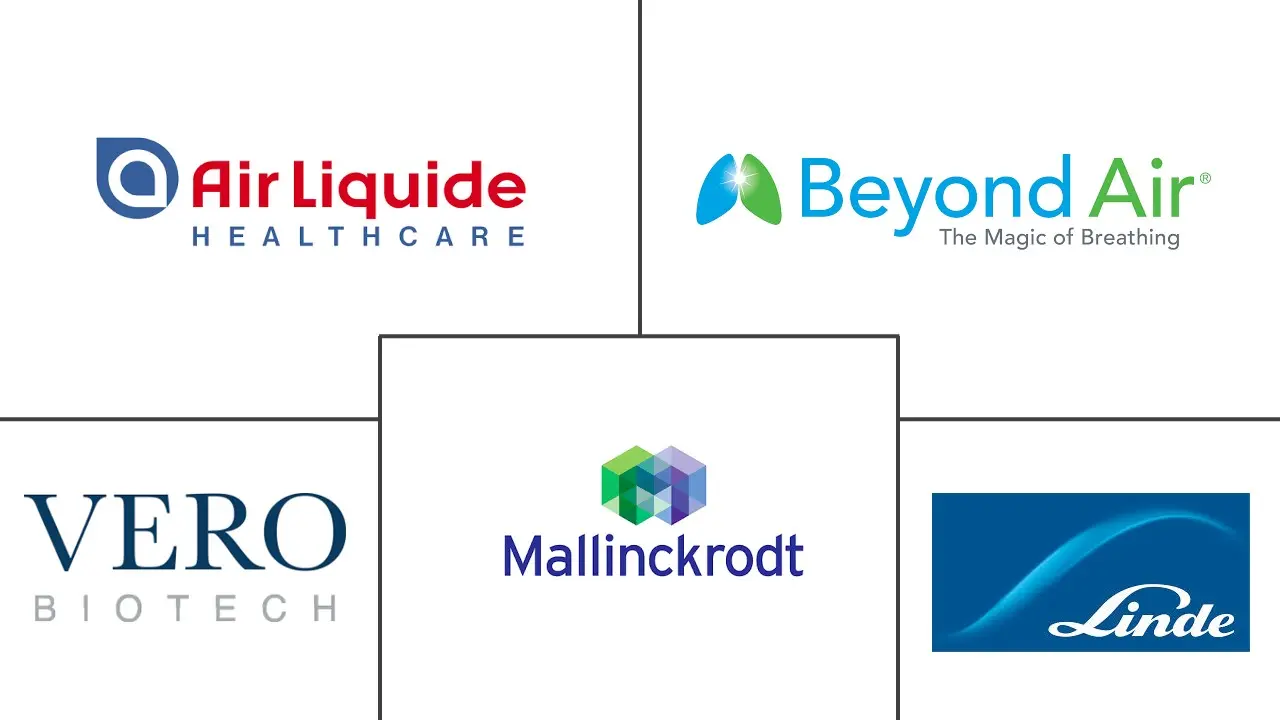Inhaled Nitric Oxide Market Size and Share
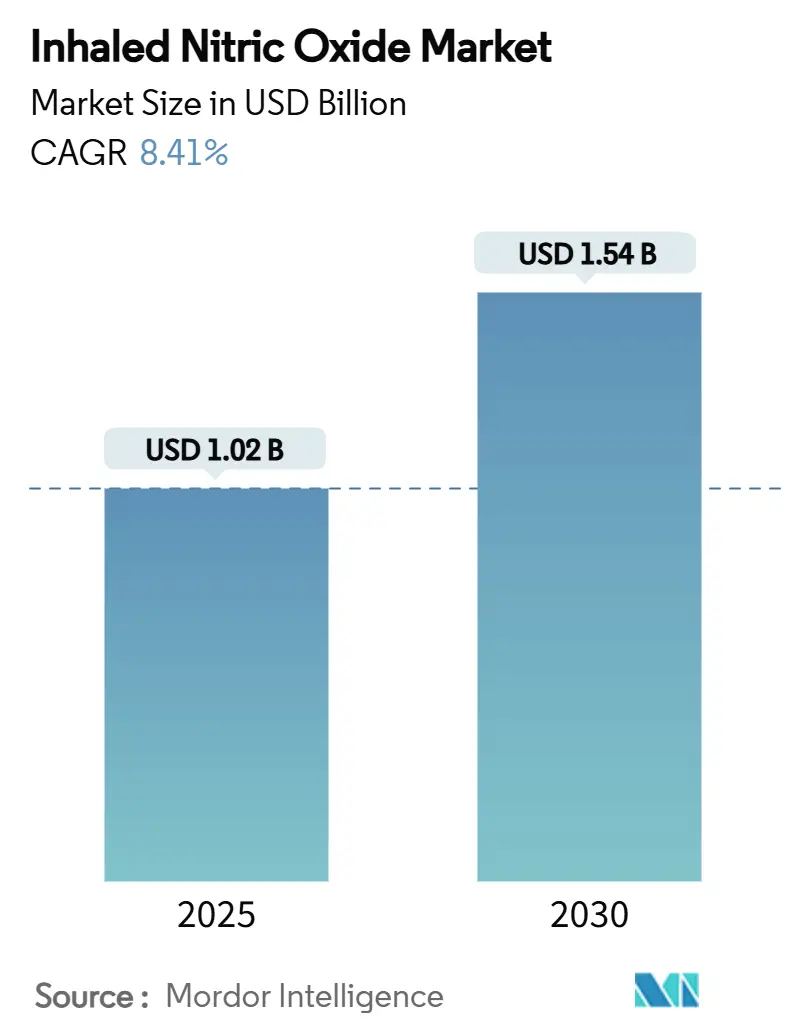
Inhaled Nitric Oxide Market Analysis by Mordor Intelligence
The inhaled nitric oxide market size is USD 1.02 billion in 2025 and is projected to reach USD 1.54 billion by 2030, reflecting an 8.41% CAGR. Robust demand for cylinder-free generators, expanding critical-care capacity across emerging economies, and sustained reimbursement for orphan drugs in high-income countries are reinforcing growth. Hospitals are pivoting toward generator-based solutions that reduce logistics costs, shrink carbon footprints, and allow bedside production of higher NO concentrations. These developments are widening access beyond tertiary centers and positioning the inhaled nitric oxide market as a core element of future respiratory care platforms. Competitive dynamics now revolve around intellectual-property-protected generation technologies, deep distribution alliances, and evidence generation for new indications.
Key Report Takeaways
- By product type, inhaled nitric oxide gas held 72.0% of inhaled nitric oxide market share in 2024, while generators and delivery systems are forecast to expand at a 10.4% CAGR through 2030.
- By application, neonatal respiratory treatment captured 64.0% revenue share in 2024; acute respiratory distress syndrome applications are expected to advance at an 11.2% CAGR between 2025-2030.
- By end user, tertiary hospitals and NICUs accounted for 83.0% of 2024 revenue; home-care settings exhibit the fastest trajectory at an 11.5% CAGR for 2025-2030.
- By geography, North America led with 49.0% revenue share in 2024, whereas Asia Pacific is projected to register a 9.2% CAGR to 2030.
Global Inhaled Nitric Oxide Market Trends and Insights
Driver Impact Analysis
| Driver | % Impact on CAGR Forecast | Geographic Relevance | Impact Timeline |
|---|---|---|---|
| Escalating burden of neonatal and acute pulmonary disorders worldwide | +2.1% | Global; higher impact in Asia Pacific and Africa | Long term (≥ 4 years) |
| Technological advancements in cylinder-free NO generation and dosing equipment | +1.8% | North America and Europe; expanding to Asia Pacific | Medium term (2-4 years) |
| Favorable orphan-drug reimbursement policies in high-income markets | +1.2% | North America and Western Europe | Short term (≤ 2 years) |
| Expanding critical-care infrastructure across emerging economies | +1.5% | Asia Pacific, Middle East, Latin America | Medium term (2-4 years) |
| Growing clinical evidence supporting off-label uses in ARDS and COVID-19 | +0.9% | Global; initial impact in North America and Europe | Medium term (2-4 years) |
| Strategic collaborations between gas giants and device manufacturers | +0.7% | North America and Europe | Short term (≤ 2 years) |
| Source: Mordor Intelligence | |||
Escalating Burden of Neonatal and Acute Pulmonary Disorders Worldwide
Persistent pulmonary hypertension of the newborn affects 1.5-2 per 1,000 term and late-preterm births, underpinning steady NICU demand. Countries with high birth rates and improving intensive-care capacity, notably India and China, are scaling nitric-oxide protocols in neonatal guidelines. In parallel, ARDS now represents roughly 10% of ICU admissions worldwide, enlarging the adult addressable pool. During the COVID-19 surge, multi-center studies reported improvements in oxygenation metrics in up to 60% of severe cases when inhaled NO was added to ventilation strategies, cementing off-label traction that continues in 2025[1]PubMed, “Inhaled Nitric Oxide in Severe COVID-19 ARDS,” pubmed.ncbi.nlm.nih.gov.
Technological Advancements in Cylinder-Free NO Generation and Dosing Equipment
Generator-based systems eliminate high-pressure cylinders, slashing storage hazards and transport costs. Beyond Air’s FDA-cleared LungFit PH produces NO on demand from ambient air at bedside concentrations up to 400 ppm, far above the 80 ppm ceiling of legacy units, and integrates with ventilators through proprietary dosing software. Hospitals benefit from simplified logistics, reduced greenhouse-gas emissions linked to cylinder deliveries, and the ability to deploy therapy in operating rooms without respiratory-therapy set-up delays.
Favorable Orphan-Drug Reimbursement Policies in High-Income Markets
In the United States, therapy priced near USD 5,280 per day remains reimbursed under specific Current Procedural Terminology (CPT) and Diagnosis-Related Group (DRG) codes. CMS coverage offsets capital costs and supports routine use in 800+ NICUs. Western European payers similarly fund therapy through national health services when nitric oxide prevents costlier escalation to extracorporeal membrane oxygenation[2]CMS, “Clinical and Payment Policies for Inhaled Nitric Oxide,” cms.gov.
Expanding Critical-Care Infrastructure Across Emerging Economies
China added about 10,000 NICU beds between 2020-2024 while India accelerated tertiary-care investments, enabling broader adoption of cylinder-based and emerging generator modalities. Multinational hospital chains share clinical protocols across Asia Pacific, Latin America, and the Gulf, fostering standardized use of inhaled nitric oxide market therapies. Enhanced medical-gas supply chains lessen logistical bottlenecks, opening the inhaled nitric oxide market to community hospitals previously constrained by storage requirements.
Restraints Impact Analysis
| Restraints Impact Analysis | (~) % Impact on CAGR Forecast | Geographic Relevance | Impact Timeline |
|---|---|---|---|
| High capital and operational costs of NO delivery systems | -1.3% | Global; greater impact in emerging markets | Medium term (2-4 years) |
| Stringent safety regulations for storage and transport of toxic gases | -0.8% | Europe and North America | Short term (≤ 2 years) |
| Availability of alternative pulmonary vasodilator therapies | -0.6% | North America and Europe | Medium term (2-4 years) |
| Patent expiries and pricing pressures reducing profit margins | -0.5% | Global; initial impact in North America | Medium term (2-4 years) |
| Source: Mordor Intelligence | |||
High Capital and Operational Costs of NO Delivery Systems
Legacy cylinder-based platforms require upfront outlays of USD 50,000-100,000 plus recurring consumable expenses near USD 3,000 per patient-day in the United States. Budget-constrained hospitals ration use to the most critical neonates and adults, limiting penetration across lower-tier centers. Even in developed markets, pharmacy committees enforce utilization protocols to curb spending, prompting interest in generator models that promise cost savings over device lifecycles.
Stringent Safety Regulations for Storage and Transport of Toxic Gases
OSHA classifies nitric oxide as a toxic gas, mandating dedicated ventilated storage rooms, continuous NO₂ monitors, and emergency response plans. Compliance workloads deter smaller facilities, especially in Europe where Seveso III directives impose additional reporting thresholds[3]EIGA, “Nitric Oxide Safety Guidelines,” eiga.eu. Generator technologies producing NO from air at point of care partially mitigate these hurdles yet still face validation testing and staff-training requirements.
Segment Analysis
By Product Type: Cylinder-Free Systems Disrupting Status Quo
The inhaled nitric oxide gas segment maintained a 72.1% revenue position in 2024. Familiarity, national formularies, and integrated cylinder supply chainshave entrenched the incumbent approach in NICUs and adult ICUs. Yet generator-based platforms are forecast to expand at 10.4% CAGR to 2030 as hospitals blend sustainability mandates with business-case savings. Cylinder-free units eliminate the need for costly bulk-gas contracts and lower carbon-emission footprints tied to transport. Device makers now bundle ventilator-compatible cartridges, software-driven dosing, and cloud diagnostics, reducing alarm fatigue and downtime. Integrated ventilator modules, deployed through partnerships between industrial-gas firms and ventilator manufacturers, streamline therapy initiation during intra-hospital transport. Accessories and consumables remain a predictable profit center, with filter and connector kits replaced on rigid preventive-maintenance cycles.
Competition now pivots on intellectual-property firewalls around plasma-ionization technology, smart-sensor feedback, and antimicrobial tubing. Market entrants tout higher maximum‐dose ceilings that allow experimental regimens in refractory hypoxemia and oncology. Generators capable of delivering 400-ppm doses at bedside encourage protocol expansion beyond conventional 80-ppm limits. These advances are reshaping procurement criteria, with purchasing teams ranking footprint, connectivity, and multiyear total-cost-of-ownership ahead of traditional per-hour pricing.
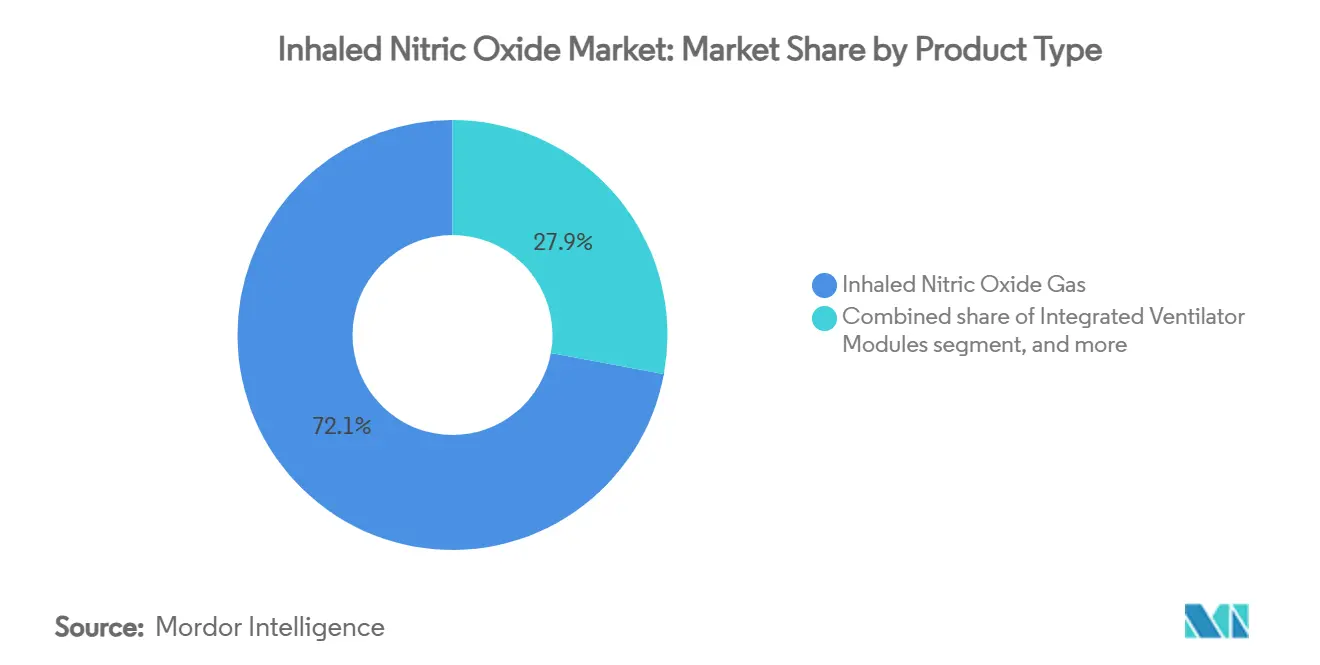
Note: Segment shares of all individual segments available upon report purchase
By Application: ARDS Expansion Beyond Traditional Neonatal Base
Neonatal respiratory therapy dominated 2024 revenue at 64.0% on the strength of FDA-approved use in persistent pulmonary hypertension of the newborn. High survival benefits and codified reimbursement codes lock in demand. Clinical focus, however, is swiftly widening to adult ARDS. The ARDS segment is projected to post an 11.2% CAGR to 2030, the highest among all applications. Large randomized trials during and after the COVID-19 crisis showed inhaled nitric oxide improving PaO₂/FiO₂ ratios and facilitating ventilator weaning in a subset of hypoxemic adults. Intensivists are now including nitric oxide in rescue-oxygenation algorithms for trauma-induced lung injury and extracorporeal-membrane support.
Investigators are also exploring nitric-oxide antimicrobial effects for drug-resistant pneumonia, tuberculosis, and malaria. Phase II protocols testing 160-ppm intermittent dosing regimes in infectious diseases may unlock entirely new patient cohorts. Cardiac-surgery teams employ short-term nitric oxide to mitigate right-heart failure during reperfusion, while lung-transplant units examine perioperative NO to improve graft function. These developments collectively enlarge the clinical canvas on which the inhaled nitric oxide market grows.
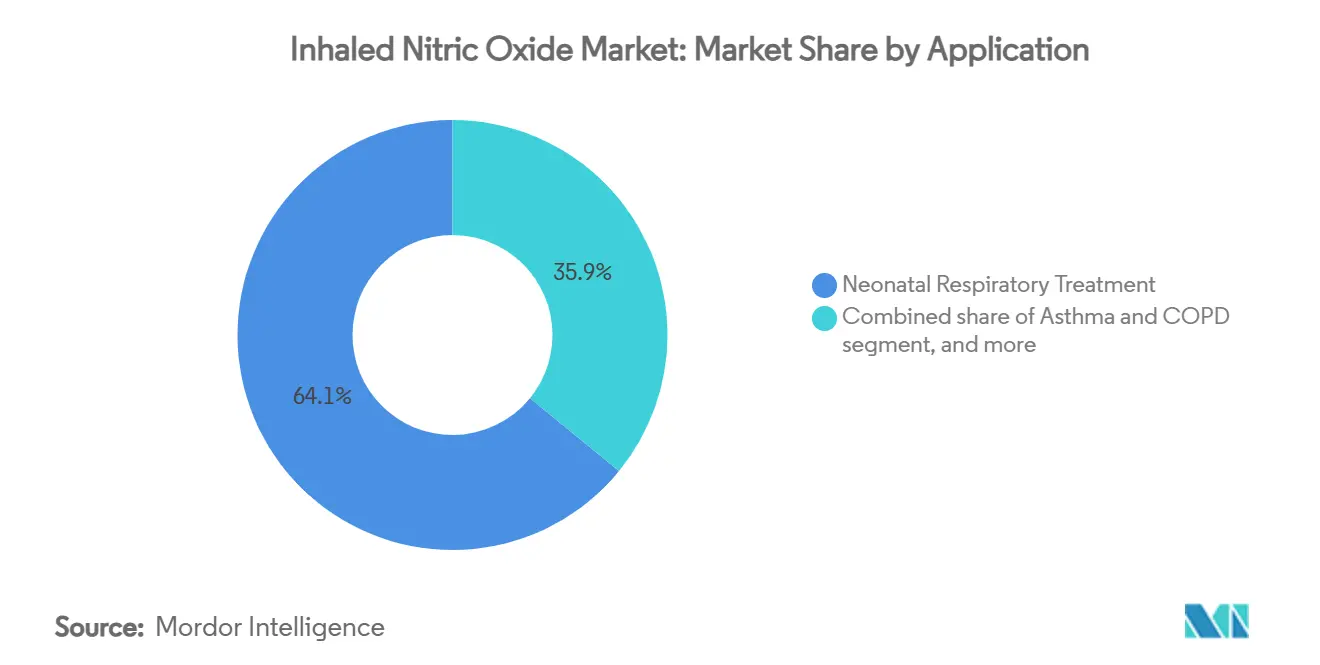
Note: Segment shares of all individual segments available upon report purchase
By End-User: Home Care Expansion Challenging Hospital Dominance
Tertiary hospitals and NICUs represented 83.0% of 2024 sales. High-acuity caseloads, round-the-clock respiratory-therapist staffing, and on-site biomedical departments justify investment in capital-intensive systems. Yet the fastest growth to 2030 lies in home care, tracking an 11.5% CAGR as portable generator devices win regulatory nods. Third Pole Therapeutics’ eNOfit portable cartridge exemplifies this movement by enabling chronic-disease patients to self-administer low-dose nitric oxide under telemonitoring. Specialty pulmonary clinics are adopting compact wheeled systems for outpatient infusions in interstitial-lung-disease–associated hypertension. Ambulatory-surgical centers use nitric oxide to stabilize high-risk pulmonary-hypertension cases during orthopedic or abdominal procedures.
Adoption outside hospital walls depends on battery runtime, Bluetooth-enabled dosage logs, and payer willingness to reimburse oxygenation endpoints tracked remotely. Device makers are bundling analytics dashboards that feed cloud registries, thus supporting value-based-care contracts. Successful transition to outpatient and home care will recast revenue recognition toward annuity-style disposable sales, diversifying earnings streams for manufacturers active in the inhaled nitric oxide market.
Geography Analysis
North America remained the epicenter of the inhaled nitric oxide market in 2024, generating 49% of global revenue. Roughly 25,000 U.S. neonates receive therapy each year across more than 800 NICUs. Medicare, Medicaid, and most private insurers reimburse USD 3,000-plus daily therapy costs, protecting provider margins. Canada shows rising adoption in provincial tertiary centers, while Mexico is incorporating nitric oxide into updated neonatal hypoxic-failure guidelines amid hospital-modernization funding. Regional growth is underpinned by early-stage home-therapy trials enrolling pulmonary-hypertension patients discharged with portable generators.
Asia Pacific is the fastest-growing territory, with inhaled nitric oxide market revenues primed for a 9.2% CAGR. China’s Healthy China 2030 blueprint prioritizes neonatal-mortality reduction, spurring procurement of advanced respiratory modalities in top-tier urban hospitals. The National Health Commission green-lighted reimbursements for persistent pulmonary-hypertension protocols that include nitric oxide, boosting penetration from 65 major facilities in 2023 to more than 140 in 2025. Japanese hospitals report the highest per capita utilization, reflecting universal coverage and mature NICU networks. India’s public–private NICU expansion and large annual birth cohort create long-term upside, although gaps in rural infrastructure constrain near-term uptake.
Europe generated about 30% of 2024 revenue, led by Germany, France, and the United Kingdom. Reimbursement is contingent on cost-utility analysis, so hospitals evaluate total oxygenator days avoided and ECMO deferrals when justifying purchases of next-generation devices. Cylinder-free generators resonate with sustainability mandates embedded in European Green Deal agendas. Eastern-European adoption is accelerating through EU-funded hospital-upgrade programs. The Middle East counts fewer total treatments but high revenue per site as Gulf Cooperation Council hospitals procure premium generator-ventilator bundles for new-build NICUs. African uptake remains nascent except in South-Africa-based academic centers focused on neonatal-asphyxia reduction.
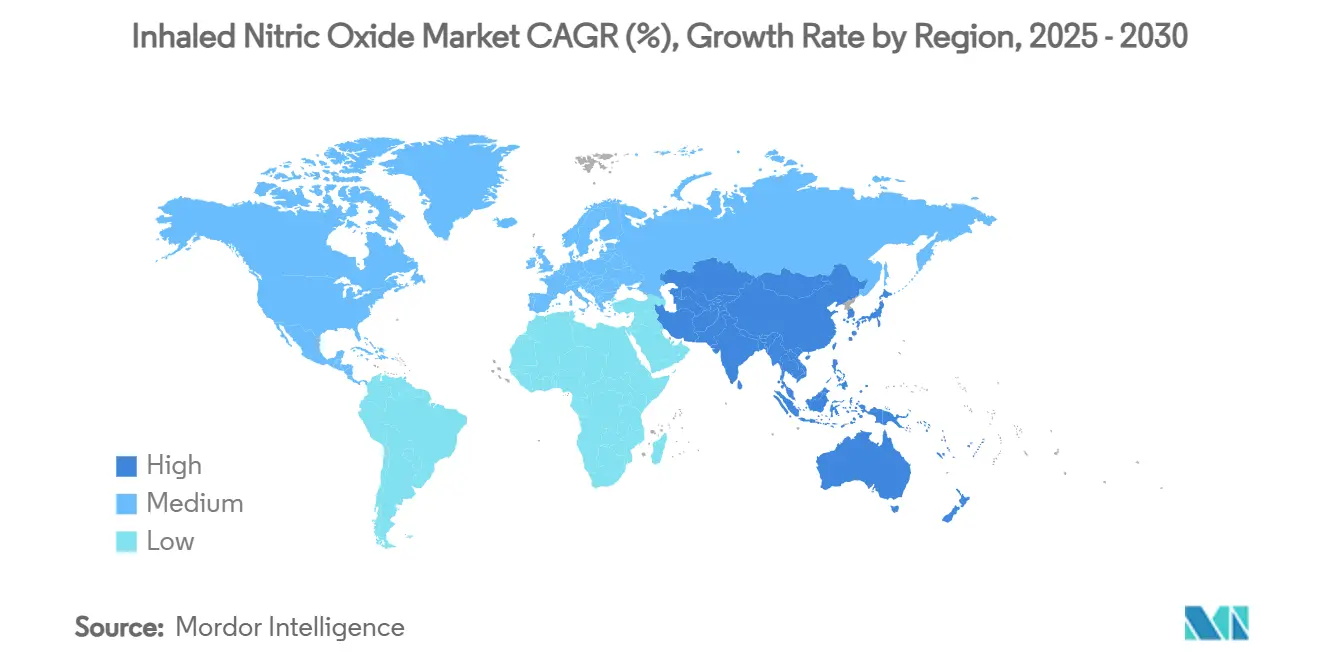
Competitive Landscape
The inhaled nitric oxide market features moderate concentration. Mallinckrodt, Linde, and Air Liquide controlled roughly 75% combined revenue in 2024. Mallinckrodt leverages its INOmax Total Care program that bundles delivery systems, disposables, on-site staff training, and 24/7 clinical hotlines, establishing sticky customer relationships. Linde and Air Liquide exploit vertically integrated gas supply chains to bundle cylinder deliveries with ventilator interfaces in one procurement contract.
Disruption is underway from generator specialists such as Beyond Air, VERO Biotech, and Third Pole Therapeutics. Beyond Air’s LungFit PH avoids high-pressure cylinders by creating nitric oxide from ambient air via plasma ionization. FDA clearance in 2022 set a precedent for tank-free models. VERO’s GENOSYL DS mini-cylinder delivery system uses on-cart cartridges that weigh under 9 kg, solving transport bottlenecks within large hospitals. Third Pole’s eNOfit aims to extend therapy to home settings.
Strategic collaborations define current competition. Linde partners with Hamilton Medical to develop ventilator-integrated dosing, while Air Liquide teams with Getinge on closed-loop feedback algorithms. Patent expirations on older cylinder-dosing technology intensify price competition but simultaneously propel generator uptake as hospitals weigh upgrade paths. Suppliers differentiate by embedding wireless telemetry, real-time NO₂ sensing, and cybersecurity layers that comply with FDA and EU medical-device regulations.
Inhaled Nitric Oxide Industry Leaders
-
Mallinckrodt Pharmaceuticals plc
-
Linde plc
-
Air Liquide Healthcare
-
VERO Biotech LLC
-
Beyond Air Inc.
- *Disclaimer: Major Players sorted in no particular order
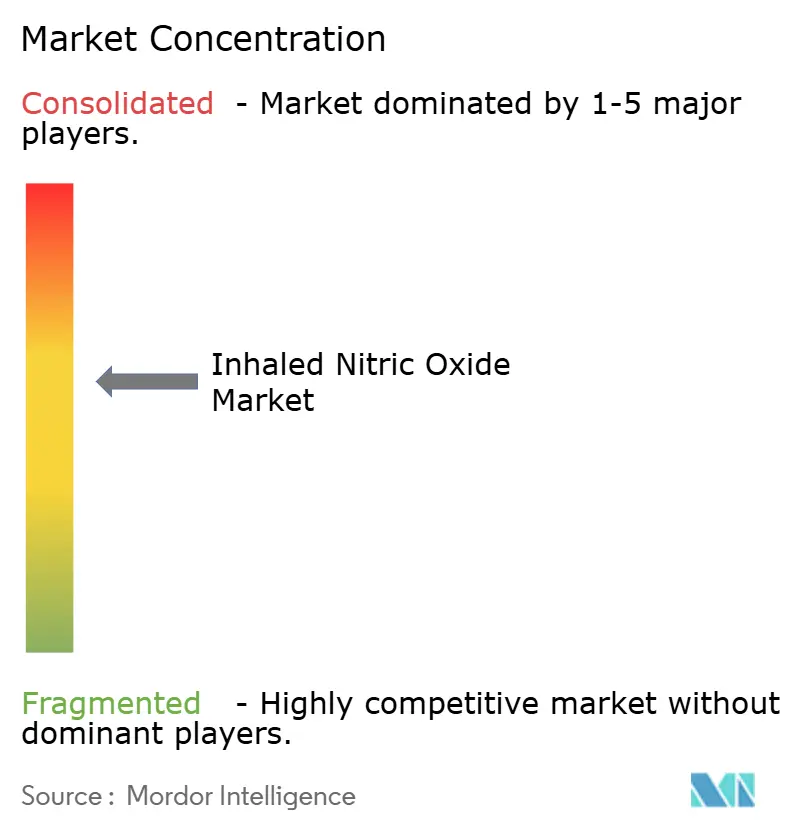
Recent Industry Developments
- May 2025: Beyond Air named Vanderbilt University Medical Center as the first U.S. luminary site for LungFit PH, showcasing cylinder-free delivery to potential adopters.
- March 2025: Beyond Air secured CE-Mark–enabled distribution for LungFit PH in 18 countries, receiving initial orders from France, Turkey, Romania, and Morocco.
- January 2025: Australia’s Therapeutic Goods Administration granted market authorization to LungFit PH as a Class IIb ventilator-compatible device.
- December 2024: Beyond Cancer, a Beyond Air subsidiary, won Israeli approval for a Phase 1b trial of ultra-high-concentration nitric oxide with anti-PD-1 in unresectable tumors.
- October 2024: Mallinckrodt began expanded U.S. rollout of the INOmax EVOLVE DS delivery system featuring mini-cylinder technology and integrated automation.
Global Inhaled Nitric Oxide Market Report Scope
Nitric oxide is a gas that is inhaled, and it works by relaxing smooth muscles to dilate blood vessels, especially in the lungs. The gas is mainly used in a breathing machine (ventilator) to treat respiratory failure in premature babies and treat COPD and ARDS. The Inhaled Nitric Oxide Market is segmented by Product Type (Gas and Delivery Systems), Application (Neonatal Respiratory Treatment, Asthma and COPD, Acute Respiratory Distress Syndrome, Malaria Treatment, Tuberculosis Treatment, and Other Applications), and Geography (North America, Europe, Asia-Pacific, Middle East, and Africa, and South America). The market report also covers the estimated market sizes and trends for 17 countries across major regions globally. The report offers the value (in USD million) for the above segments.
| Inhaled Nitric Oxide Gas |
| Nitric Oxide Generators & Delivery Systems |
| Integrated Ventilator Modules |
| Accessories & Consumables |
| Neonatal Respiratory Treatment |
| Asthma and COPD |
| Acute Respiratory Distress Syndrome |
| Malaria Treatment |
| Tuberculosis Treatment |
| Other Applications |
| Tertiary Hospitals & NICUs |
| Specialty Pulmonary Clinics |
| Ambulatory Surgical Centres |
| Home-Care Settings |
| North America | United States |
| Canada | |
| Mexico | |
| Europe | Germany |
| United Kingdom | |
| France | |
| Italy | |
| Spain | |
| Rest of Europe | |
| Asia Pacific | China |
| Japan | |
| India | |
| Australia | |
| South Korea | |
| Rest of Asia Pacific | |
| Middle East & Africa | GCC |
| South Africa | |
| Rest of Middle East & Africa | |
| South America | Brazil |
| Argentina | |
| Rest of South America |
| By Product Type | Inhaled Nitric Oxide Gas | |
| Nitric Oxide Generators & Delivery Systems | ||
| Integrated Ventilator Modules | ||
| Accessories & Consumables | ||
| By Application | Neonatal Respiratory Treatment | |
| Asthma and COPD | ||
| Acute Respiratory Distress Syndrome | ||
| Malaria Treatment | ||
| Tuberculosis Treatment | ||
| Other Applications | ||
| By End-User | Tertiary Hospitals & NICUs | |
| Specialty Pulmonary Clinics | ||
| Ambulatory Surgical Centres | ||
| Home-Care Settings | ||
| Geography | North America | United States |
| Canada | ||
| Mexico | ||
| Europe | Germany | |
| United Kingdom | ||
| France | ||
| Italy | ||
| Spain | ||
| Rest of Europe | ||
| Asia Pacific | China | |
| Japan | ||
| India | ||
| Australia | ||
| South Korea | ||
| Rest of Asia Pacific | ||
| Middle East & Africa | GCC | |
| South Africa | ||
| Rest of Middle East & Africa | ||
| South America | Brazil | |
| Argentina | ||
| Rest of South America | ||
Key Questions Answered in the Report
What is the current value of the inhaled nitric oxide market?
The inhaled nitric oxide market size is USD 1.02 billion in 2025 and is projected to reach USD 1.54 billion by 2030 at an 8.41% CAGR.
Which application segment is growing the fastest?
Acute respiratory distress syndrome treatments show the highest growth, expanding at an 11.2% CAGR as evidence for adult use strengthens.
How are generator-based systems changing hospital economics?
Cylinder-free generators cut storage hazards, reduce transport emissions, and lower long-term operating costs, making nitric oxide therapy practical for more care settings.
Which region offers the most attractive growth prospects?
Asia Pacific leads global momentum with a projected 9.2% CAGR, supported by NICU expansion in China and India and rising reimbursement access.
Who are the leading companies in the inhaled nitric oxide market?
Mallinckrodt, Linde, and Air Liquide dominate with about 75% combined share, while innovators like Beyond Air and VERO Biotech are rapidly gaining traction.
Page last updated on:
